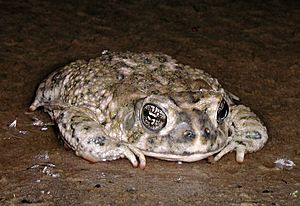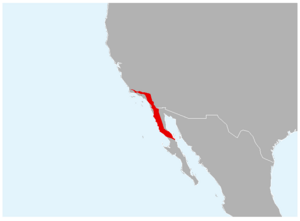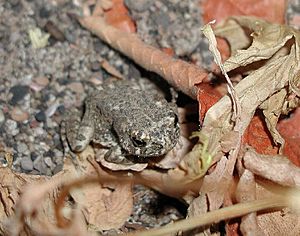Arroyo toad facts for kids
Quick facts for kids Arroyo toad |
|
|---|---|
 |
|
| Conservation status | |
| Scientific classification | |
 |
|
| Synonyms | |
|
The arroyo toad (Anaxyrus californicus) is a type of true toad. It lives only in California (USA) and the Baja California state in Mexico. This toad is currently listed as an Endangered species. This means it is in danger of disappearing forever. Its main threat is habitat destruction, which is when its natural home is damaged or removed.
Contents
What Does the Arroyo Toad Look Like?
The arroyo toad is a sturdy toad with a blunt nose and bumpy skin. It is about 5 to 7.5 centimeters (2 to 3 inches) long. It has horizontal pupils in its eyes. Its back, called the dorsum, can be greenish, grey, or salmon-colored. It has a light-colored stripe across its head and eyelids.
You can also spot light patches on its lower back and middle of its back. It has large, oval glands behind its eyes called parotoid glands. These glands are far apart. Young arroyo toads are usually ash-white, olive, or salmon on their backs. They might have black spots. They also have red-tipped bumps on their backs.
Where Do Arroyo Toads Live?
Anaxyrus californicus likes sandy or rocky streambeds. These streambeds often have fast-flowing water. They also live in the nearby dry land and riverbank areas. You can find them in Southern California, from Santa Barbara County south into northwestern Baja California.
An arroyo is a dry creek or riverbed. In the desert, it is called a wash. These areas fill with water and flow only after heavy rain. Arroyo toads live near these creeks and rivers. They prefer shallow, pebble-like rocks near sandy areas. Adult toads dig into the sandy soil for safety and shelter. They also lay their eggs there. They usually choose areas with very little or no plants.
How Do Arroyo Toads Behave?
The arroyo toad is nocturnal, meaning it is active at night. It spends most of the day underground. However, during mating season, you might see it during the day near the shallow parts of a pond. It moves by hopping quickly, not by walking. When it hunts for food, it lunges at its prey. It uses its large, sticky tongue to catch and eat insects, usually ants.
During the dry season, the arroyo toad goes into a deep sleep called aestivation. This helps it avoid drying out. This sleepy state usually happens underground in soil or clay-like sand. It lasts from August to January.
Reproduction
The arroyo toad's breeding season is in late winter and early spring. This happens after the seasonal rains. The male toad picks a spot near a river or water bank. He then makes mating calls to attract a female toad. They mate in a position called amplexus. The female toad then returns to the same spot to lay her eggs in the water.
She lays an average of 4,700 eggs in two rows. Where the eggs are placed in the water is very important. If some eggs are too far from the water, they will dry out and die. Eggs can also fall into deep water and be eaten by predators. The eggs that survive hatch in about four to six days.
What Do Arroyo Toads Eat?
When the eggs hatch, the tiny larvae eat tiny living things called microbes. These microbes are found in the sand near the water where they hatched. Young arroyo toads mostly eat ants and other small insects. As they grow, their diet changes to include small beetles. Adult toads usually eat caterpillars, moths, crickets, and snails. Sometimes, they even eat the eggs and larvae of other arroyo toads.
How Do Arroyo Toads Defend Themselves?
Anaxyrus californicus protects itself with a toxin found on its skin. This toxin is released from its parotoid glands. These glands look like pale spots near the toad's head. The main part of this venom is called bufotoxin. The venom on the toad's skin is strong enough to cause serious problems for an attacker.
If a human touches the toad's skin, it can cause serious irritation and pain. This can affect the throat, eyes, nose, and mouth. It can also affect the heart and breathing. If this happens, it is important to seek medical attention. There is no special medicine to stop the venom. Treatment depends on the symptoms.
Another way the toad defends itself is by hiding. It can hide in plants or underwater to escape from attackers.
Who Are Their Predators?
The arroyo toad is good at hiding. However, it can still be attacked by many different predators. Eggs and larvae can be eaten by fish, other types of frogs (even adult arroyo toads), birds, snakes, and insects that live in the water.
Adult arroyo toads are also hunted by predators. These include American Bullfrogs and garter snakes. Even if they escape, they might die from injuries caused by their attackers. American Bullfrogs often attack male toads when they are making mating calls. They will also attack toads while they are mating. This stops the toads from reproducing. This greatly affects the number of arroyo toads in the wild.
Conservation Efforts
There are fewer than 3,000 arroyo toads that can breed. Only six of the 22 known groups south of Ventura have more than a dozen adult toads. The toad has disappeared from about 75% of the areas where it used to live in the U.S.
The biggest threats to the arroyo toad come from human activities. These activities include farming, building roads, using off-road vehicles, and mining. All of these can destroy or change the toad's habitat. They can also change how rivers flow. Other smaller threats include new predators like bullfrogs and fish that are not native to the area. Invasive plants (plants that don't belong there) are also a problem. Droughts, wildfires, and efforts to stop wildfires can also hurt them. Water released from dams at the wrong times, and light and noise from nearby towns, are also threats.
On March 27, 2014, the Department of Fish and Wildlife suggested changing the arroyo toad's status. They recommended it be changed from Endangered to Threatened. The agency said the arroyo toad still faces "significant threats." These include how dams are used, water being moved away, city growth, new predator species, and drought. However, they felt that conditions had gotten better. They said that the threats have decreased partly because of conservation efforts.
See also
 In Spanish: Anaxyrus californicus para niños
In Spanish: Anaxyrus californicus para niños



